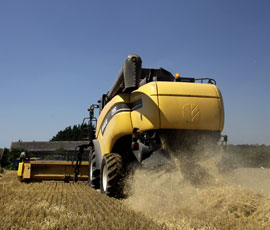UK barley exports – markets and opportunities

There are fewer destinations for UK barley than other agricultural commodities.
In the 2011/12 season, the UK exported around 803,915t of barley, with the vast majority, 718,376t, going to EU countries. Exports accounted for 15% of production.
Germany is Europe’s largest importer of malting barley with France, Denmark and the UK the main exporters.
While export markets are currently good, the UK may export less in the 2012/13 season, according to Jack Watts, senior analyst at AHDB.
“German production in 2012 is expected to be higher, possibly reducing import needs,” said Mr Watts.
“Production is also expected to be higher in France and Denmark, meaning that the export market is increasingly competitive.”
The bad weather affecting this year’s harvest could also compound barley export problems in the coming year, he added. “There are some crop concerns this year over both yield and quality due to the poor summer weather.”
The UK also exported 193,143t of malt in 2011/12, with more than 95% of this going outside the EU. The biggest buyers of UK malt are east Asian countries such as Japan, Taiwan, Thailand, South Korea, Vietnam and Laos. The US and Caribbean countries also buy large volumes.
It takes 1.3t of barley to produce 1t of malt.
In 2011/12, Malta bought more than a quarter of the UK’s total exports to the EU.
The picture in the UK
In general, area and production have fallen back over the past 25-30 years, due to more profitable wheat and oilseed rape crops.
Plantings in 2012 were up 3% on the previous year, according to the HGCA GB planting survey, but this is from a relatively low base.
The past 15 years have seen a shift from winter varieties to a larger proportion of spring varieties.
The UK market
Spring varieties make up about 65% of what English maltsters are looking for from the 2012 crop, with the bulk of this (80%) at a maximum of 1.56-1.85% nitrogen.
Among winter barleys the requirements are similar, but a larger proportion (about 16%) is needed at lower than 1.55% nitrogen.
Scotland’s maltsters want 90% spring varieties, with just over half of these at lower than 1.55% nitrogen and about 27% in the 1.55-1.65% band. Almost all of the winter malting barley required by Scottish maltsters is in the 1.66-1.85% nitrogen band.
UK maltings are concentrated in East Anglia and Scotland but there are also sites in Yorkshire, Hertfordshire, Wiltshire, Staffordshire and Devon.
On the south coast of England, the target market is export and supplying East Anglia, which has a malting barley deficit.
The food processing industry is also an important malt customer.
The north of England supplies increasing volumes of spring barley into the Scottish market to meet demand from the distilling sector.
While demand in Scotland is growing, fuelled by export demand for Scotch whisky, English demand from the brewing sector is in decline due to weak beer sales. This is partly offset by the growth of micro breweries.
Recent achievements
The UK is exporting to fewer countries than it has done previously, but volumes have steadily grown over the past five years, with only small stocks carried over to the following cereal year.
Outside the EU, Arab nations are typically the largest buyers of UK barley, however, the tonnage exported to Russia has grown by more than 450% year on year in the 2011/12 season.
Saudi Arabia is the largest global importer of barley and historically has bought large tonnages from the UK, although it bought none in 2011-12.
To see more export maps of key commodities, visit www.fwi.co.uk/exportmaps
